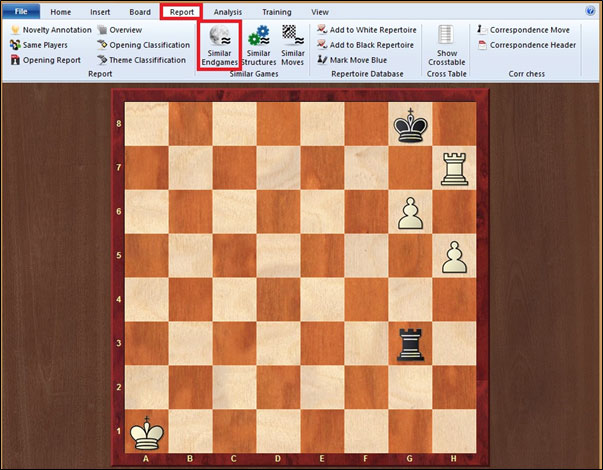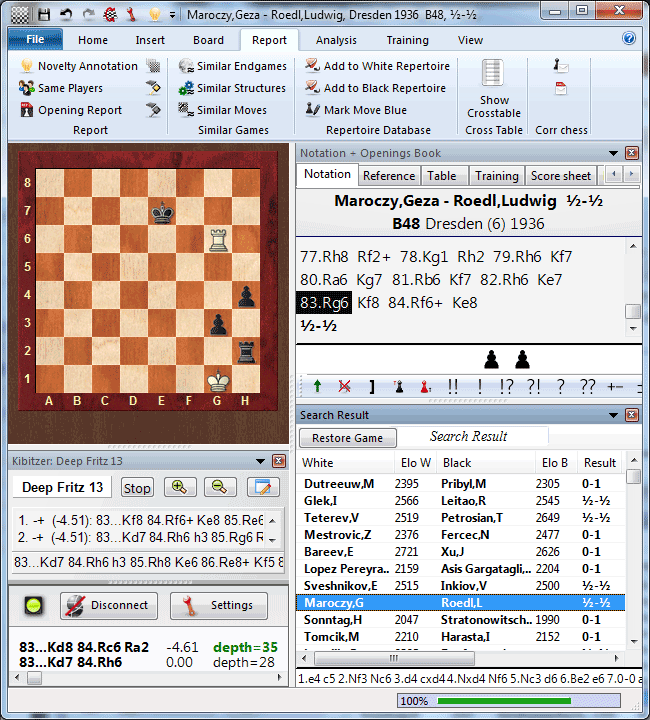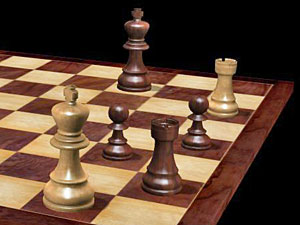The best way to learn endgames
By Sagar Shah
As I said in Friday's article: studying John Nunn's example an endgame position that often occurs in practical play is very useful: it can bring concrete returns in your next tournament. But remembering the technique, the subtle intricacies, over a long period of time is another matter. But it can be done by studying similar positions that have occurred in real games. Once you have seen half a dozen examples from games of other players, it is almost impossible to forget the analyses and its conclusions.
In this context I showed you how you can find the positions to study, with a single mouse click in ChessBase 13.

Set up the position you would like to study and then click on “Similar Endgames” in the “Report” tab

ChessBase looks into all the games of your reference database and find the endgames which are similar to the one that you want to study. They appear as a list on the right of the screen. Note that clicking on a game will load it and jump to the endgame we are studying. You can even switch on a chess engine to assist you in your analysis.
With ChessBase 13 I found many endgames that were similar to the Kasparian study Nunn had used to explain the strategy and short listed six positions for you to study over the weekend. Did you find the solutions? Well, here they are now for you to varify.

[Event "Dresden"] [Site "Dresden"] [Date "1936.??.??"] [Round "6"] [White "Maroczy, Geza"] [Black "Roedl, Ludwig"] [Result "1/2-1/2"] [ECO "B48"] [Annotator "Sagar Shah"] [SetUp "1"] [FEN "8/4k3/7R/8/7p/6p1/7r/6K1 b - - 0 79"] [PlyCount "11"] [EventDate "1936.??.??"] [EventRounds "9"] [EventCountry "GER"] [Source "ChessBase"] [SourceDate "1999.07.01"] {This one was a pretty easy one!} 79... Kf7 $1 $19 {Black has a won position as this is a reciprocal zugzwang position with White to move.} 80. Ra6 Kg7 $4 { A very bad blunder by Roedl that throws away the win.} (80... Rb2 {was the simplest way.} 81. Rh6 (81. Ra4 h3 $19) 81... Rb4 82. Kg2 Kg7 83. Rh5 Kg6 84. Rh8 Rb2+ 85. Kg1 Kg5 $19) 81. Rb6 Kf7 82. Rh6 $1 $11 {and now the same position of reciprocal zugzwang with a small difference. It is Black to play!} Ke7 83. Rg6 $1 Kf8 84. Rf6+ $1 {Maroczy doesn't let the draw slip now.} Ke8 $11 {and a draw was agreed.} 1/2-1/2

[Event "GER-ch op U25"] [Site "Willingen"] [Date "2006.06.06"] [Round "5"] [White "Sonntag, Hermann"] [Black "Stratonowitsch, Andre"] [Result "0-1"] [ECO "B23"] [WhiteElo "2047"] [BlackElo "1990"] [Annotator "Sagar Shah"] [SetUp "1"] [FEN "8/5k2/7R/8/7p/6p1/7r/6K1 b - - 0 74"] [PlyCount "40"] [EventDate "2006.06.04"] [EventRounds "9"] [EventCountry "GER"] [Source "ChessBase"] [SourceDate "2006.11.23"] {White has the draw within his grasp as in this reciprocal zugzwang position it is Black to move.} 74... Kg7 75. Ra6 $1 Rb2 76. Ra4 Rh2 {Black is forced to go back as} (76... h3 {is met by} 77. Rg4+ $11) 77. Ra6 {So far so good!} Kf7 78. Rh6 $1 {Still going strong.} Ke7 79. Rg6 $1 Kf8 80. Rh6 $4 {And there comes the blunder. This position has been difficult even for grandmasters who haven't studied it before. So you cannot expect a 2047 player to play it with a hundred per cent accuracy.} ({As we already know, the right move is} 80. Rf6+ $1 Ke7 81. Rg6 $11) 80... Kf7 $1 {And now it is zugzwang time for White.} 81. Ra6 Rc2 $1 82. Rh6 Rc4 $19 {The rest is not difficult.} 83. Kg2 Rg4 (83... Kg7 {is the easiest way to do it.} 84. Ra6 Rc2+ 85. Kh3 (85. Kg1 h3 $19) 85... Rh2+ 86. Kg4 g2 $19) 84. Ra6 (84. Rh7+ Kg6 85. Rh8 {was more tenacious but will lose in the long run.}) 84... h3+ 85. Kxh3 g2 86. Kxg4 g1=Q+ 87. Kh5 Qd1+ 88. Kg5 Qd2+ 89. Kh4 Qf4+ 90. Kh5 Qf5+ 91. Kh6 Qh3+ 92. Kg5 Qg2+ 93. Kh4 Qe4+ 94. Kg5 {Black soon won.} 0-1

[Event "Athens"] [Site "Athens"] [Date "1983.??.??"] [Round "10"] [White "Sveshnikov, Evgeny"] [Black "Inkiov, Ventzislav"] [Result "1/2-1/2"] [ECO "B14"] [WhiteElo "2515"] [BlackElo "2500"] [Annotator "Sagar Shah"] [SetUp "1"] [FEN "6k1/R7/6P1/7P/8/8/p6K/r7 b - - 0 58"] [PlyCount "57"] [EventDate "1983.12.??"] [EventRounds "11"] [EventCountry "GRE"] [EventCategory "8"] [Source "ChessBase"] [SourceDate "1999.11.16"] {The threat is h6 and Black has to do something about it right away. Inkiov has a great handle on this ending.} 58... Rb1 $1 59. Rxa2 Rb5 $1 {The pawn cannot be pushed as Rh5+ would lose it. Hence White has to check and make his rook passive.} 60. Ra8+ Kg7 61. Ra7+ Kg8 62. Rh7 Rb3 $1 {Cutting off the king on the thrid rank. As we already know, if the white king is on the g and the h file and cut off on the third rank, this position is drawn.} 63. Kg2 Ra3 $1 { Waiting.} 64. Kf2 Rh3 $1 {Excellent. Our basic position of reciprocal zugzwang. } 65. Ke2 Rg3 $1 {Waiting on an opposite coloured square!} (65... Rb3 $2 66. Ra7 $1 Rb5 67. h6 $18) 66. Kf1 Rf3+ $1 {Important check!} 67. Ke1 Re3+ 68. Kd1 Rd3+ {Checking till White decides to come to the second rank.} 69. Kc2 {Light square chosen by the white king.} Rg3 $1 {Dark square it is for the rook.} 70. Kb2 Rh3 71. Kc1 Rc3+ $1 {Inkiov knows all the subtleties.} 72. Kd2 Rh3 $1 73. Ke2 Rg3 74. Kf2 Rh3 $1 75. h6 {Finally Sveshnikov pushes the pawn. But now it is a simple draw. Black has just to wait.} Rh2+ 76. Kf3 (76. Kg3 Rh1 77. Kg4 Rg1+ 78. Kf5 Rf1+ {With a rain of checks.}) 76... Rh1 77. Kf4 Rf1+ 78. Kg5 Rg1+ 79. Kf6 Rf1+ 80. Ke6 Re1+ 81. Kd7 Rd1+ 82. Kc7 Rc1+ 83. Kd6 (83. Kd8 {And now the key move} Rc6 $1 84. Rg7+ Kh8 85. Kd7 Rc7+ $1 $11) 83... Rg1 84. Rg7+ Kh8 85. Ke7 {With the black king in a stalemate, the rook can now sacrifice itself. } Re1+ 86. Kf7 Re7+ {Great defensive effort by Ventzislav Inkiov.} 1/2-1/2

[Event "World op 34th"] [Site "Philadelphia"] [Date "2006.06.30"] [Round "3"] [White "Ippolito, Dean"] [Black "Ganguly, Surya Shekhar"] [Result "1/2-1/2"] [ECO "D78"] [WhiteElo "2413"] [BlackElo "2578"] [Annotator "Sagar Shah"] [SetUp "1"] [FEN "7k/R7/6P1/7P/8/8/p6K/r7 b - - 0 56"] [PlyCount "24"] [EventDate "2006.06.28"] [EventRounds "9"] [EventCountry "USA"] [Source "ChessBase"] [SourceDate "2006.07.14"] {It makes absolutely no difference that the king is on h8 instead of g8. As Surya Shekhar Ganguly shows the draw can be achieved by following what Inkiov did.} 56... Rb1 $1 57. Rxa2 Rb5 58. Ra8+ {As this check had to be given and the king has to move to g7, it didn't matter whether the king was on g8 or h8 in the initial position.} Kg7 59. Ra7+ Kg8 60. Rh7 Rb3 $1 {And there we are back to the Kasparyan study.} 61. Kg2 Ra3 62. Kf1 Rf3+ $1 63. Ke2 Rg3 $1 64. Kf2 Rh3 65. Ke2 Rg3 66. Kd1 Rd3+ 67. Kc2 Rg3 68. Kd2 {Text book defence by the Indian grandmaster and Dean Ippolito concedes the half point.} 1/2-1/2

[Event "CZE-chT 1314"] [Site "Czechia"] [Date "2014.02.16"] [Round "8.1"] [White "Carlsson, Pontus"] [Black "Mista, Aleksander"] [Result "1/2-1/2"] [ECO "C55"] [WhiteElo "2499"] [BlackElo "2582"] [Annotator "Sagar Shah"] [SetUp "1"] [FEN "8/1R3pk1/8/6PP/6P1/8/r3pK2/8 b - - 0 64"] [PlyCount "26"] [EventDate "2013.11.02"] [EventType "tourn"] [EventRounds "11"] [EventCountry "CZE"] [Source "ChessBase"] [SourceDate "2014.11.20"] 64... Ra4 $6 {Though this is not the most accurate move it does not through away the draw.} (64... Kg8 {This was the easiest way to achieve the draw.} 65. Re7 e1=Q+ 66. Kxe1 Ra4 $11) 65. g6 Rxg4 66. Rxf7+ Kg8 67. Kxe2 (67. Rf5 { trying to avoid the Kasparyan position would not work because of} Rg2+ $1 68. Ke1 Rh2 69. Re5 Kg7 70. Re7+ Kg8 71. Rh7 Rg2 $11) 67... Rg5 $1 {Important move to make the white rook passive.} 68. Rh7 Rg3 $1 {Cutting off the king.} 69. Kf2 Rh3 $1 {Reciprocal Zugzwang.} 70. Kg2 Ra3 $1 71. Kf2 Rh3 72. Kg1 Rg3+ $1 73. Kh2 Rb3 74. Kg2 Ra3 75. Kf1 Rf3+ 76. Ke2 Rg3 77. Kf2 {Mista played the Kasparian endgame very accurately and was duly rewarded with the half point.} 1/2-1/2

[Event "Liechtenstein op 15th"] [Site "Liechtenstein"] [Date "1997.??.??"] [Round "8"] [White "Dutreeuw, Marc"] [Black "Pribyl, Martin"] [Result "0-1"] [ECO "B63"] [WhiteElo "2395"] [BlackElo "2305"] [Annotator "Sagar Shah"] [SetUp "1"] [FEN "8/7k/R7/8/p7/1p6/r7/1K6 w - - 0 68"] [PlyCount "12"] [EventDate "1997.??.??"] [EventRounds "9"] [EventCountry "LIE"] [Source "ChessBase"] [SourceDate "1998.11.10"] {This sequence of six moves, that is twelve individual moves there are as many as nine mistakes!} 68. Kc1 $2 (68. Rb6 $1 {was the correct way to maintain the balance.}) 68... Kg7 $2 (68... Rc2+ $1 69. Kb1 Rc4 {The rook has now activated itself and it is a pretty easy win.} 70. Rb6 Kg7 71. Kb2 Kf7 72. Ka3 Ke7 73. Ra6 Kd7 74. Rb6 (74. Ra5 Kc6 $19) 74... Kc7 75. Ra6 Kb7 76. Rh6 Rc1 $1 77. Rh7+ (77. Kb2 Rc2+ 78. Kb1 a3 79. Rh3 a2+ $19) (77. Rg6 Rc2 78. Rg7+ Kc6 79. Rg6+ Kc5 80. Rg5+ Kc4 81. Rg4+ Kd3 82. Rg3+ Kd2 83. Rg2+ Ke3 84. Rg3+ Kf2 $19 {This same manoeuvre could not be executed when the rook was on the h-file.}) 77... Kc6 78. Rh6+ Kd5 79. Rh5+ Ke4 80. Rh4+ Kd3 81. Rh3+ (81. Rxa4 Kc3 $19) 81... Kc2 82. Rh2+ Kb1 83. Kxa4 Rc3 $1 $19 (83... b2 $2 84. Kb3 $11)) 69. Kb1 Kf7 70. Rh6 $2 (70. Rb6 $1 $11) 70... Ke7 $2 {Black could have activated his rook.} ( 70... Rg2 $1 71. Rh4 (71. Ra6 Rg4 $19) 71... a3 $19) 71. Rg6 $2 (71. Ra6 $1 $11 ) 71... Kd7 $2 (71... Rh2 $1 $19) 72. Rh6 $2 (72. Rb6 $1 Kc7 73. Ra6 $11 { Reciprocal zugzwang position.}) 72... Kc7 $2 (72... Rg2 $1 $19) 73. Rg6 $2 (73. Ra6 $1 $11) 73... Rh2 $19 {Finally!} 0-1
After working on these six practical positions I am sure that you are never really going to forget this ending! Even if someone woke you up in the middle of the night you would be able to accurately tell them the secrets of this endgame! And it is precisely for this reason I think that the “Similar Endgame” function in ChessBase 13 is one of the best ways to learn endgames for a tournament player.
Order ChessBase 13 here


























